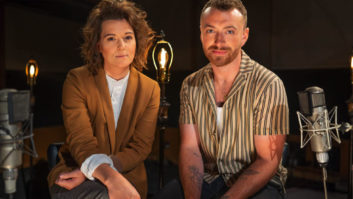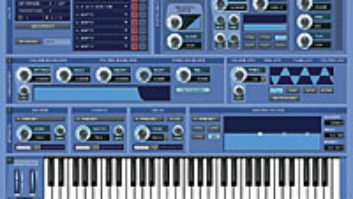A massive JBL VerTec rig, shown here being hung for the first time, is at the heart of Radio City’s system.
When you’re putting a permanent house sound system into one of the most famous performance spaces in the world, you don’t mess around—which is why Radio City Music Hall pulled out all the stops for its new system. Late August in 2007 saw the culmination of a nearly two-year long effort to improve sound within the venerable venue.

While it was a process championed at multiple levels of the company, all the way up to Radio City Entertainment president, Jay Marciano, and Madison Square Garden chairman, Jim Dolan, likely no one was more pleased than head sound engineer, Tom Arrigoni. Standing behind the desk at the mezzanine-based FOH position a week after the installation, he grinned, “The first thing you notice about this system is it’s insanely quiet and it’s got enough power to knock you over.” As he pushed up a fader, no one landed on the floor but instead, a sample CD could be cleanly heard filling every corner of the roughly 6,000-seat room.
Just as there was plenty of new equipment at work, likewise, there were a number of people who poured in countless hours into making the system happen. “It was designed by Jim Devenney and Gene Pelland of Clair Brothers,” said Arrigoni. “Those guys did an outstanding job with the design and system drawings; I can’t say enough about their work.” At the same time, Tim Hassett, EVP Facilities, Madison Square Garden, Richard Claffey, SVP and General Manager, Radio City Facilities and Arrigoni brought in design and consulting firm Wrightson, Johnson, Haddon & Williams (WJHW) to serve as consultant of record for the project, and to specify the venue’s new house sound system.
To top it off, Radio City also created an advisory board of independent concert engineers Tom Young (Tony Bennett, Frank Sinatra), Dave Natale (Rolling Stones, Tina Turner), and Brian Ruggles (Billy Joel, Don Henley) to vette the proposed systems. The three engineers may have backgrounds mixing different musical genres, but they were able to concur on the system easily. “We were in agreement in a very short time after one meeting,” said Natale. Young agreed, noting, “It was interesting that once we all sat in the room and discussed our ideas we were all in agreement on what would work best for Radio City Music Hall. Our approach was to design a system that would have visiting and in-house sound engineers—and performers—in mind. We wanted a system that would be widely accepted by all technical contract riders, so that any show coming into Radio City would use the designed installed system.”
The end result is based around two columns and a center cluster of JBL VerTec line array boxes. Above each side of the stage hang 15 VerTec VT4889 full-size line array elements, while a VT4800-DA array frame is used to suspend a pair of VT4887A compact line array loudspeakers beneath each main array. A center cluster of eight VT4887As supplements the main system, while two arrays of eight VT4880A arrayable subwoofers each provide extended low-frequency output.
Typically the boxes are hung from “A Cove,” the first arch in the glittering proscenium ceiling, but can be moved to B Cove when necessary, such as when the venue plays host to a TV production like Fashion Rocks and needs the PA out of sight to facilitate clear camera angles. “It’s flexible,” said Arrigoni, “because what if lighting wants to put a gigantic truss in? They all have to work together, and we can accommodate that.”
Supporting the new hangs are a dozen custom EAW under-balcony speakers; the RC 646 is a JF-80 modified for Radio City (hence the “RC”), replacing the conical horn with a 60×40-degree horn and a different crossover.
Not all the loudspeakers hung in Radio City are for the audience, however; part of the system renewal included an update to the stage monitoring with the inclusion of 12 L-Acoustics Arcs front- and side-fill cabinets. A total of four Arcs are hung on each side of the stage, between the various front curtains, to provide zone-specific coverage for on-stage performers. It’s a key part of the system, especially for productions that feature the Rockettes, such as the Christmas Spectacular, which plays to over 1 million visitors during its 224 performances per holiday season. The dancers have to hear every note of music, but personal monitor systems and wedges are out of the question, making a tightly focused hanging monitor system to be of the utmost importance. The remaining four Arcs are “roamers,” placed as needed.
Powering all the performance loudspeakers throughout the venue are a slew of new amplifiers, encased in rolling racks on a platform that sits above one of the most jaw-dropping sights hidden from view at Radio City: the top-side of the coves. Once used for prop storage, the now-encaged platform looks out above a rolling gray hill of plaster, chicken wire, steel and 6-inch-wide maintenance ladders, but just as impressive is what’s inside the cage: racks and racks of QSC amplifiers. PowerLight 340s and 380s are used for the VerTec line arrays, while PL236s and 218s handle the venue’s old Altec system, first installed in 1978 and still used for low-key spoken word events like graduations. Finally, QSC 1.8s power the EAW under-balcony boxes.
“We went with QSC because we had a lot of QSC, they have a good reputation, they hold up well and a good amp definitely affects the sound,” said Arrigoni. “The 380s weren’t even available when we wrote up the first proposal. They’re all networked with our Dolby Lake system and we have a QSC CM16A system monitor, which monitors all the amps, the load, the temperature, whatever you need. We were supposed to have this whole comparison shoot-off between different brands, and because of time, it never worked out. These worked out to be a better value and I think they sound better.”
Arrigoni was also pleased to have a dozen Dolby Lake Processors at his finger tips, all tied into a wireless table PC. “That’s one of the coolest things I’ve found; I can walk around and adjust level and EQ right on the fly,” he noted. “The Dolby Lakes are going to hold their own in our system for a long time; they should, because they sound really good. Between them and the amps, it’s a beast.”
Getting touring sound engineers involved as consultants definitely paid off as well; Natale remarked that fall, “I’ve already mixed Fashion Rocks, The Dream Concert (a benefit for the Martin Luther King Memorial in Washington, DC) and a show called Rock Corp there, and the system performed perfectly each time. It was very easy to get a sound that I was comfortable with; in fact, on the Dream Concert, we were running behind on the production load-in day, and the Ricky Miner Band walked on-stage about two minutes after we got power at the FOH. Patrick Healy, Radio City’s assistant audio department head was with me and after we ran through all of the individual zones with pink noise to ensure that they were functioning, he said, ‘Do you want to EQ?’ I said, ‘The band is on stage and playing; just turn it on.’ He did, I un-muted the console, we listened for a second, agreed that it sounded good and went from there. Luckily, we had done two days of band rehearsals at another location and had that setup stored in the console.”
Young, too, has used the system, having mixed Tony Bennett there on the system’s third show: “The system exceeded my expectations and provided an exceptional clean and responsive sound throughout the Music Hall; the clarity and detail on vocals and instruments was complementary to the venue. The system takes one of the great acoustic halls in the US and takes it to the next level when using sound reinforcement.”
Radio City Music Hall
www.radiocity.com




